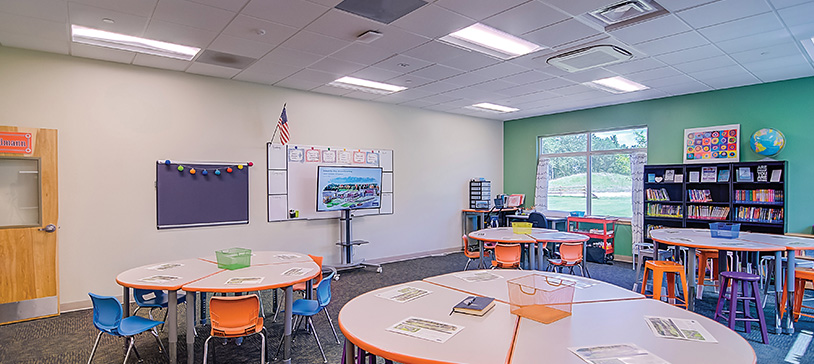
IT TAKES A VILLAGE

Why partnerships matter in building K-12 learning spaces
Lee Martin achieved the highest qualification in the education planning profession in early 2021. The veteran architect and director of the K-12 design studio for full-service architecture and engineering firm CROFT & Associates officially received the Accredited Learning Environment Planner (ALEP) designation, a mark of excellence developed to reflect the knowledge, skills and abilities of a qualified educational facility planner.
The accreditation, presented by The Association for Learning Environments (AL4E), signifies excellence in the industry. Today, Martin is one of approximately 300 ALEP designated professionals globally, and one of only two in the state of Georgia.
We sat down with Martin to get his thoughts on constructing the ideal learning environment for today’s K-12 students.

Give us a snapshot of the education landscape today.
Today is a difficult time in education. With teacher burn out, record high turnover rates, and student learning loss through the pandemic, the fallout for schools has taken a toll on the mental health and social-emotional needs of both students and educators.
Despite the challenges, this is also a potential renaissance period in education, as school systems re-examine their approach to education.
The pandemic taught us quickly that remote learning technology can be useful when implemented well. New hybrid learning environments that allow students to continue to participate in class, regardless of being at home or in the physical classroom, continue to see high demand even now, well after pandemic shutdowns.
What are some of the emerging trends around schools that you must consider in the design and redesign effort?
There is growing demand for flexible learning environments that support the curricula. Optimum environments facilitate collaboration and community building. We know that not all students learn in the same way. Allowing a variety of seating options and flexibility in learning environments improves student engagement. Project-based learning models are best supported by educational environments that support multiple, simultaneous group activities.
There is a renewed focus on CTAE with programs preparing students for the future workforce. Digital tools and technologies, such as additive manufacturing, supplement traditional shop classes. Game design has become a part of the expansion of computer programming and technology classes. Welding classes now include advanced technology, such as computer-controlled steel-cutting tools. We recently retrofitted an existing school for a new aviation flight-training simulator lab.
Can you speak to the core elements that you consider when building healthy, safe, high-performance, and sustainable learning environments?
Multiple studies show that the indoor air quality of many schools, even newer schools, is substandard. The deficit of fresh outside air allows CO2 build up in classrooms leading to sleepy students with reduced attention span, as well as teacher fatigue.
Older schools often compound that issue with return air plenums that contain concentrations of mold, decades of dust, and even friable asbestos that is not properly encapsulated (or better yet properly mitigated). This leads to higher absenteeism for both students and faculty, as well as increased asthma-related issues.
Building solar orientation, window placement, and sun-shading devices are important considerations that have long-term benefits, reducing energy demands while providing access to quality daylighting and views. Ignoring solar orientation leads to windows that face southwest and suffer horrible disruptive glare in the afternoon.
As one of a select group of ALEP designers nationwide, where do you see the intersection of learning and place?
With a mother, family members and friends who are dedicated education professionals, I know well the passion and drive they bring to their work. Great teachers will adapt to whatever learning environment you put them in. This does not excuse leadership and facility planners for failing to provide quality, evidence-based design that facilitates an optimum learning environment.
The difference between quality learning environments versus just warehousing for kids is not so much a factor of budgets but of the shared knowledge and thoughtfulness that informs the million little decisions that go into creating an education environment.
Can you speak to the core elements you consider when designing schools today?
The building’s engagement with the site and the community is a vital relationship to consider. Done well, we can put less money into site construction costs and more into the quality of the building.
Safety in schools pulls at every parent’s heartstring. While mass school shootings shock us to our core it is not the only or anywhere near the most common school safety-related issue that parents, K12 planners and facility managers should be concerned about. Media coverage of school shootings can lead to a distorted mental map of student safety risks. The natural emotional reaction is to want to overly harden schools.
Students, however, should not feel like they’re being treated as prisoners, otherwise, they start to disengage and perceive their school as a hostile environment. Successful designs improve the culture in which students live and learn, providing an environment where students feel connected to teachers, peers and a larger community.
Schools should provide more transparency and openness rather than hardening. Subtle safety interventions help to balance safety with a healthy learning environment.
How do you create that today?
Great learning environments emerge from quality planning. School planning at its best should involve student, teacher and community engagement in the predesign phase. The school facility management and operations group should always have a seat at the table, but they should not bear the burden of being the only voice at the table.
“Creating a sense of community over isolation is really critical today. I think doing that really comes through bringing everyone to the table.”
– Lee Martin, director, CROFT & Associates
Quality, responsive design begins with asking lots of questions, carefully listening to input from multiple stakeholders, and sometimes challenging preconceived ideas. Developing a quality program document provides you with a fundamental tool to deliver to the stakeholders the best value for their budget, designing great learning environments while still meeting the owner’s programmatic needs.


